Experimental Study on Freezing and Thawing Cycles of Shrinkage-Compensating Concrete with Double Expansive Agents
Abstract
:1. Introduction
2. Materials and Methods
2.1. Materials
2.2. Concrete Mixes
2.3. Experimental Procedure
2.4. SEM Analysis
- (1)
- Drill core sample: a concrete core drilling machine was used to drill a core sample with a diameter of 20 mm and a height of 100 mm at the center of the bearing surface of the concrete specimen, as shown in Figure 2a.
- (2)
- Cut thin slices: the thin slices with a thickness of 2 mm were cut at different longitudinal positions (5 mm, 10 mm, 15 mm, 20 mm, 25 mm, and 30 mm) from the erosion surface of the cylindrical core sample by using a cutter, as shown in Figure 2b.
- (3)
- Spray gold: the thin slices with a thickness of 2 mm that were cut at different longitudinal positions from the erosion surface of the cylindrical core sample in step (2) were sprayed gold. First, the cut samples were placed in an energy-saving box type electric furnace for drying about 12 h. It is considered that the drying was completed when the quality of the samples no longer changes. After the sample surface was dried, the sample was placed in an SBC-12 type ion sputtering apparatus to spray gold to the sample. The sample that was sprayed gold is shown in Figure 2c.
- (4)
- Observe: After the gold spray was completed, the sample was placed in the scanning electron microscope sample chamber for observation. Observations were conducted in an airtight reactor without adding O2, and other carrier gas.
3. Results
3.1. Analysis of Frost Resistance of Concrete
3.1.1. Slow-Damage Stage
3.1.2. Fast-Damage Stage
3.1.3. Stable Stage
3.2. SEM Analyses of Different Concretes
3.3. Comparisons with Other Methods
4. Conclusions
- (1)
- Based on the evolution of the RDME and MLR values, the change in concrete characteristics under cyclic freezing and thawing could be divided into three ages: a slow-damage age, a fast-damage age, and a stable age. In the slow-damage age, RDME and MLR values changed very little, with average decline and growth rates of 9.51% and 0.97%, respectively. By contrast, there were significant changes during the fast-damage age, with average decline and growth rates of 13.65% and 2.19%, respectively. As the freezing and thawing cycles continued into the stable age, the RDME and MLR values stabilized, with average decline and growth rates of 3.84% and 1.13%, respectively.
- (2)
- The concrete with UEA had a better frost resistance than other concrete during the slow-damage ages, with RDME and MLR values 17.80% higher and 74.49% lower respectively, than that of an expansive-agent-free concrete. But it rapidly lost its frost resistance during the fast-damage age, eventually losing its application properties. From a long-term perspective, the addition of double expansive agents in concrete was found to have a significant impact on the frost resistance and was associated with high RDMEs and MLRs. The frost resistance of the concrete was most improved at a UEA: MEA ratio of 2:1, with RDME and MLR values 17.35% higher and 25.1% lower respectively, than that of an expansive-agent-free concrete. The next-best results obtained at a ratio of 4:1.
- (3)
- Analysis of the concrete microstructures revealed that the internal pores of the UM21 were filled by large quantities of hydration products. As a result, the UM21 was more compact than either the UM10 or C and fewer microcracks appeared over the course of the freezing and thawing cycles.
- (4)
- To protect water conservancy infrastructure suffering from freezing and thawing cycles, it is suggested that a 2:1 UEA: MEA mix should be used. This mixture should effectively compensate the shrinkage and creep of the concrete and, as a result, improve the frost resistance of the hydraulic concrete and extend the service life of the infrastructure.
Author Contributions
Funding
Conflicts of Interest
References
- Ng, S.; Justnes, H. Influence of plasticizers on the rheology and early heat of hydration of blended cements with high content of fly ash. Cement Concr. Compos. 2015, 65, 41–54. [Google Scholar] [CrossRef]
- Cao, Q.; Gao, Q.Q.; Gao, R.X.; Jia, J.Q. Chloride penetration resistance and frost resistance of fiber reinforced expansive self-consolidating concrete. Constr. Build. Mater. 2018, 158, 719–727. [Google Scholar] [CrossRef]
- Xue, H.; Shen, X.; Liu, Q.; Wang, R.; Liu, Z.; Han, C. Effect of wind-sand erosion on frost resistance durability of hydraulic engineering concrete in cold irrigation area. Trans. Chin. Soc. Agric. Eng. 2017, 33, 133–140. [Google Scholar]
- Zhao, R.H.; Weng, Y.B.; Tuan, C.Y.; Xu, A. The influence of water/cement ratio and air entrainment on the electric resistivity of ionically conductive mortar. Materials 2019, 12, 1125. [Google Scholar] [CrossRef] [Green Version]
- Thomas, R.J.; Lezama, D.; Peethamparan, S. On drying shrinkage in alkali-activated concrete: Improving dimensional stability by aging or heat-curing. Cement Concr. Res. 2016, 91, 13–23. [Google Scholar] [CrossRef] [Green Version]
- Söylev, T.A.; Özturan, T. Durability, physical and mechanical properties of fiber-reinforced concretes at low-volume fraction. Constr. Build. Mater. 2014, 73, 67–75. [Google Scholar] [CrossRef]
- Sakulich, A.R.; Bentz, D.P. Mitigation of autogenous shrinkage in alkali activated slag mortars by internal curing. Mater. Struct. 2013, 46, 1355–1367. [Google Scholar] [CrossRef]
- Coppola, L.; Coetti, D.; Crotti, E.; Marini, A.; Passoni, C.; Pastore, T. Lightweight cement-free alkali-activated slag plaster for the structural retrofit and energy upgrading of poor quality masonry walls. Cement Concr. Compos. 2019, 104, 103341. [Google Scholar] [CrossRef]
- Tittelboom, K.V.; Belie, N.D. Self-healing in cementitious materials—A review. Materials 2013, 6, 2182–2217. [Google Scholar] [CrossRef] [Green Version]
- Huang, K.; Deng, M.; Mo, L.; Wang, Y. Early age stability of concrete pavement by using hybrid fiber together with MgO expansion agent in high altitude locality. Constr. Build. Mater. 2013, 48, 685–690. [Google Scholar] [CrossRef]
- Choi, H.; Choi, H.; Lee, B.; Lee, D.E. Shrinkage and durability evaluation of environmental load-reducing FRPCM by using silicone oil. Materials 2019, 12, 1240. [Google Scholar] [CrossRef] [PubMed] [Green Version]
- Miao, M.; Liu, Q.Y.; Zhou, J.; Feng, J.J. Effects of expansive agents on the early hydration kinetics of cementitious binders. Materials 2019, 12, 1900. [Google Scholar] [CrossRef] [PubMed] [Green Version]
- Liu, P.; Chen, Z.Y.; Deng, M. Regulating the expansion characteristics of cementitious materials using blended MgO-Type expansive agent. Materials 2019, 12, 976. [Google Scholar] [CrossRef] [PubMed] [Green Version]
- Carballosa, P.; Calvo, J.L.G.; Revuelta, D. Influence of expansive calcium sulfoaluminate agent dosage on properties and microstructure ofexpansive self-compacting concretes. Cement Concr. Compos. 2020, 107, 103464. [Google Scholar] [CrossRef]
- Li, C.; Shang, P.; Li, F.; Feng, M.; Zhao, S. Shrinkage and mechanical properties of self-compacting SFRC with calcium-sulfoaluminate expansive agent. Materials 2020, 13, 588. [Google Scholar] [CrossRef] [PubMed] [Green Version]
- Xu, A.; Zeng, L.; Liu, G. Study on crack resistance of roller compacted concrete with mgo contents. J. Hydroelectr. Eng. 2015, 34, 20–26. [Google Scholar]
- Sherir, M.A.A.; Hossain, K.M.A.; Lachemi, M. Self-healing and expansion characteristics of cementitious composites with high volume fly ash and MEA-type expansive agent. Constr. Build. Mater. 2016, 127, 80–92. [Google Scholar] [CrossRef]
- Wyrzykowski, M.; Terrasi, G.; Lura, P. Expansive high-performance concrete for chemical-prestress applications. Cement Concr. Res. 2018, 107, 275–283. [Google Scholar] [CrossRef]
- Mo, L.; Deng, M.; Wang, A. Effects of MgO-based expansive additive on compensating the shrinkage of cement paste under non-wet curing conditions. Cement Concr. Compos. 2012, 34, 377–383. [Google Scholar] [CrossRef]
- Sung, C.; Gum-Sung, R.; Kyeong-Taek, K.; Gi-Hong, A.; Hyeong-Yeol, K. Experimental study on the shrinkage behavior and mechanical properties of AAM mortar mixed with CSA expansive additive. Materials 2019, 12, 3312. [Google Scholar]
- Na, S.; Song, M.; Kang, S.; Lee, S.; Kim, K. Synthesis and properties of calcium sulphoaluminate using fluidised-bed boiler ash. Mater. Res. Innov. 2015, 19, S8-779–S8-783. [Google Scholar] [CrossRef]
- GB175-2007. Standard for Ordinary Portland Cement; China Architecture & Building Press: Beijing, China, 2007. (In Chinese) [Google Scholar]
- Monosi, S.; Troli, R.; Favoni, O.; Tittarelli, F. Effect of sra on the expansive behaviour of mortars based on sulphoaluminate agent. Cement Concr. Compos. 2011, 33, 485–489. [Google Scholar] [CrossRef]
- GB/T 1346-2011. Water Consumption, Setting Time and Soundness of Cement Standard Consistency; China Architecture & Building Press: Beijing, China, 2011. (In Chinese) [Google Scholar]
- GB/T 50082-2009. Standard for Test Methods of Long-Term Performance and Durability of Ordinary Concrete; China Architecture & Building Press: Beijing, China, 2009. (In Chinese) [Google Scholar]
- Zengwei, P.; Huiguang, Y.; Lianying, Z.; Ruixue, L.; Bing, L.I.; Zeqing, W. Experimental research of the effect of fly ash on the frost resistance of concrete. Concrete 2015, 37, 53–56. (In Chinese) [Google Scholar]
- Lei, Z.; Yu, H.; Baomin, W.; Yong, K.; Qi, Z. Frost resistance property of concrete doped with scrap rubber powder in sodium sulfate solution erosion environment. J. Solid Waste Technol. Manag. 2015, 41, 304–314. [Google Scholar] [CrossRef]
- ASTM. Standard Specification for Portland Cement; ASTM C150; ASTM: West Conshohocken, PA, USA, 2016. [Google Scholar]
- Hargis, C.W.; Telesca, A.; Monteiro, P.J.M. Calcium sulfoaluminate (ye\”elimite) hydration in the presence of gypsum, calcite, and vaterite. Cement Concr. Res. 2014, 65, 15–20. [Google Scholar] [CrossRef]
- Mo, L.; Fang, J.; Hou, W.; Ji, X.; Yang, J.; Fan, T. Synergetic effects of curing temperature and hydration reactivity of MgO expansive agents on their hydration and expansion behaviors in cement pastes. Constr. Build. Mater. 2019, 207, 206–217. [Google Scholar] [CrossRef]
- Sherir, M.A.A.; Hossain, K.M.A.; Lachemi, M. Permeation and transport properties of self-healed cementitious composite produced with MgO expansive agent. J. Mater. Civ. Eng. 2018, 30, 04018291. [Google Scholar] [CrossRef]
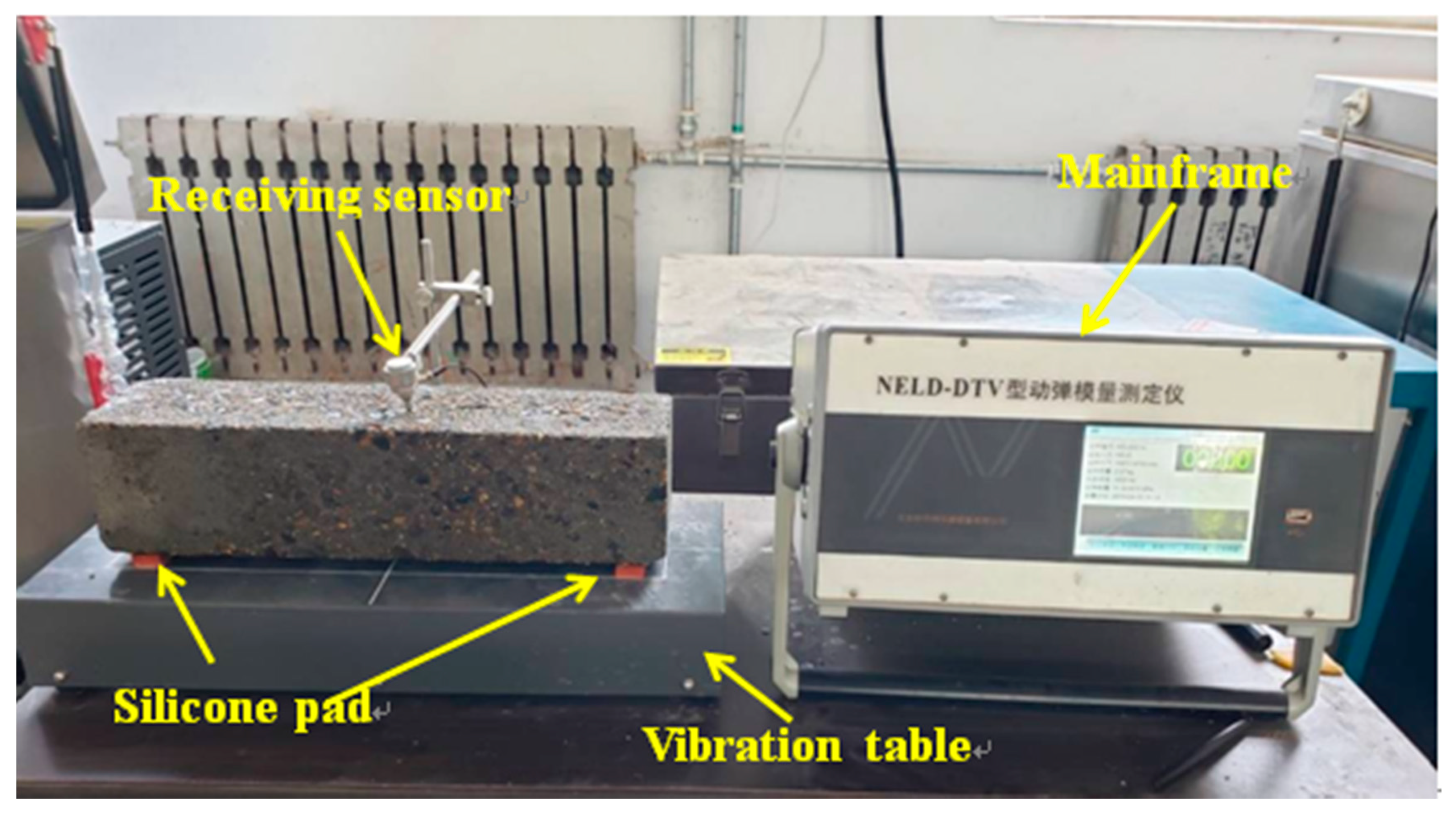
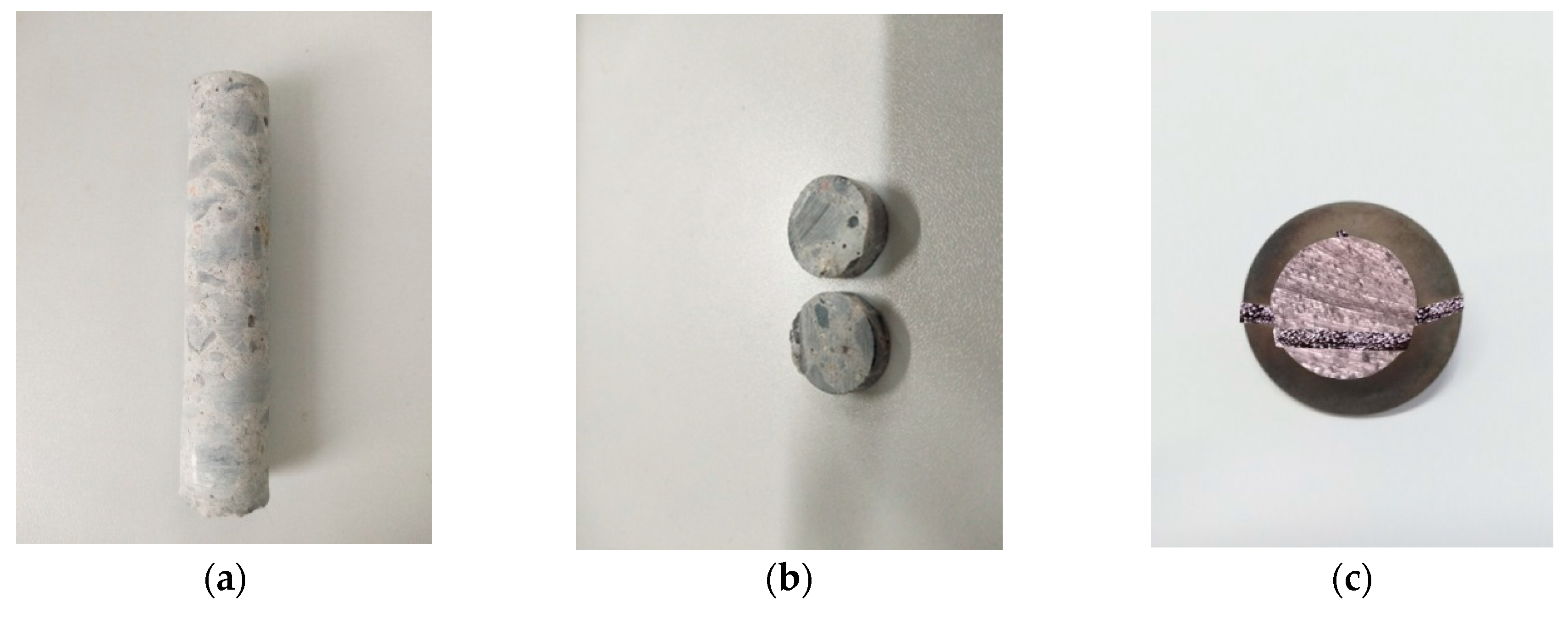
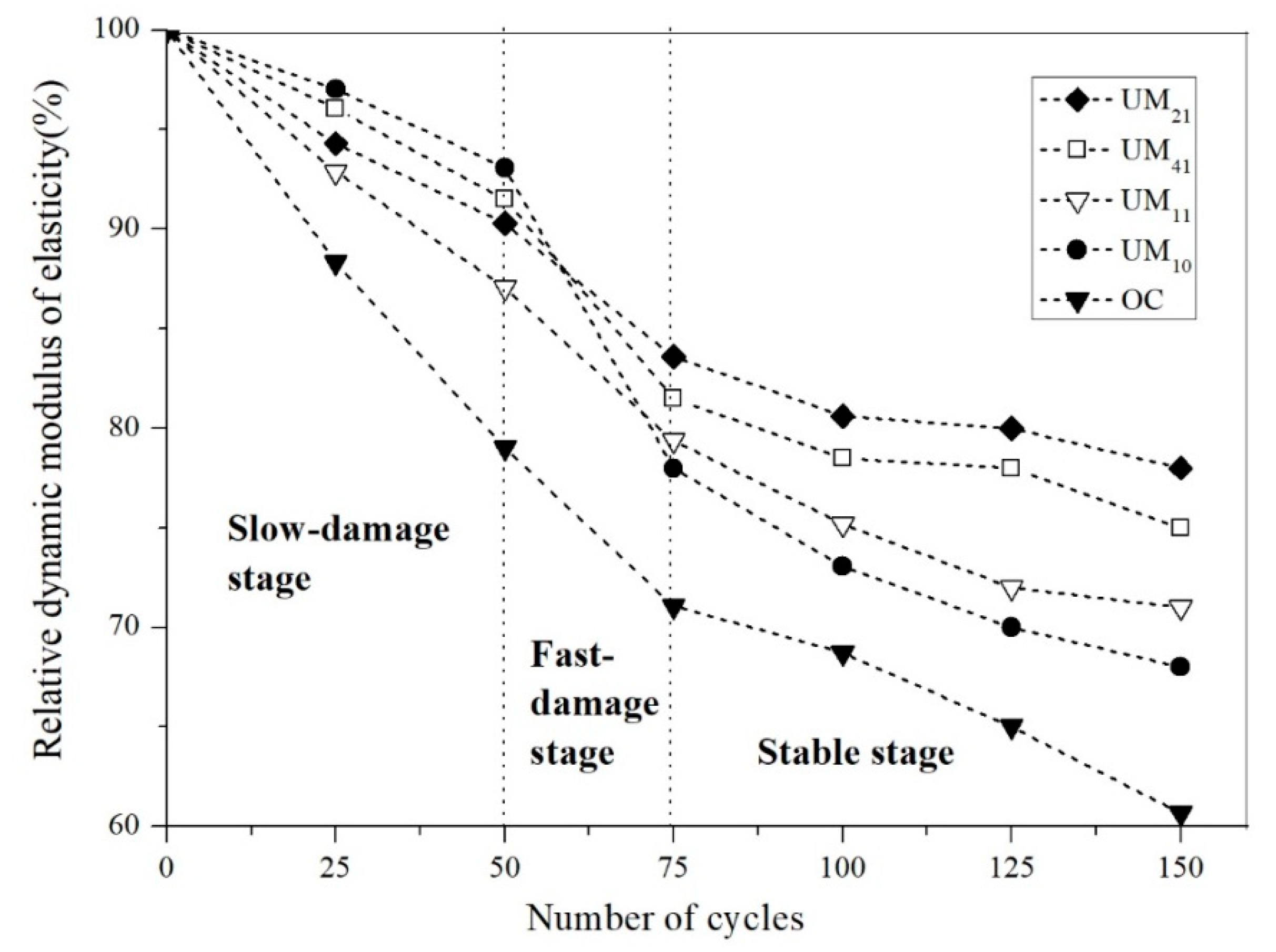
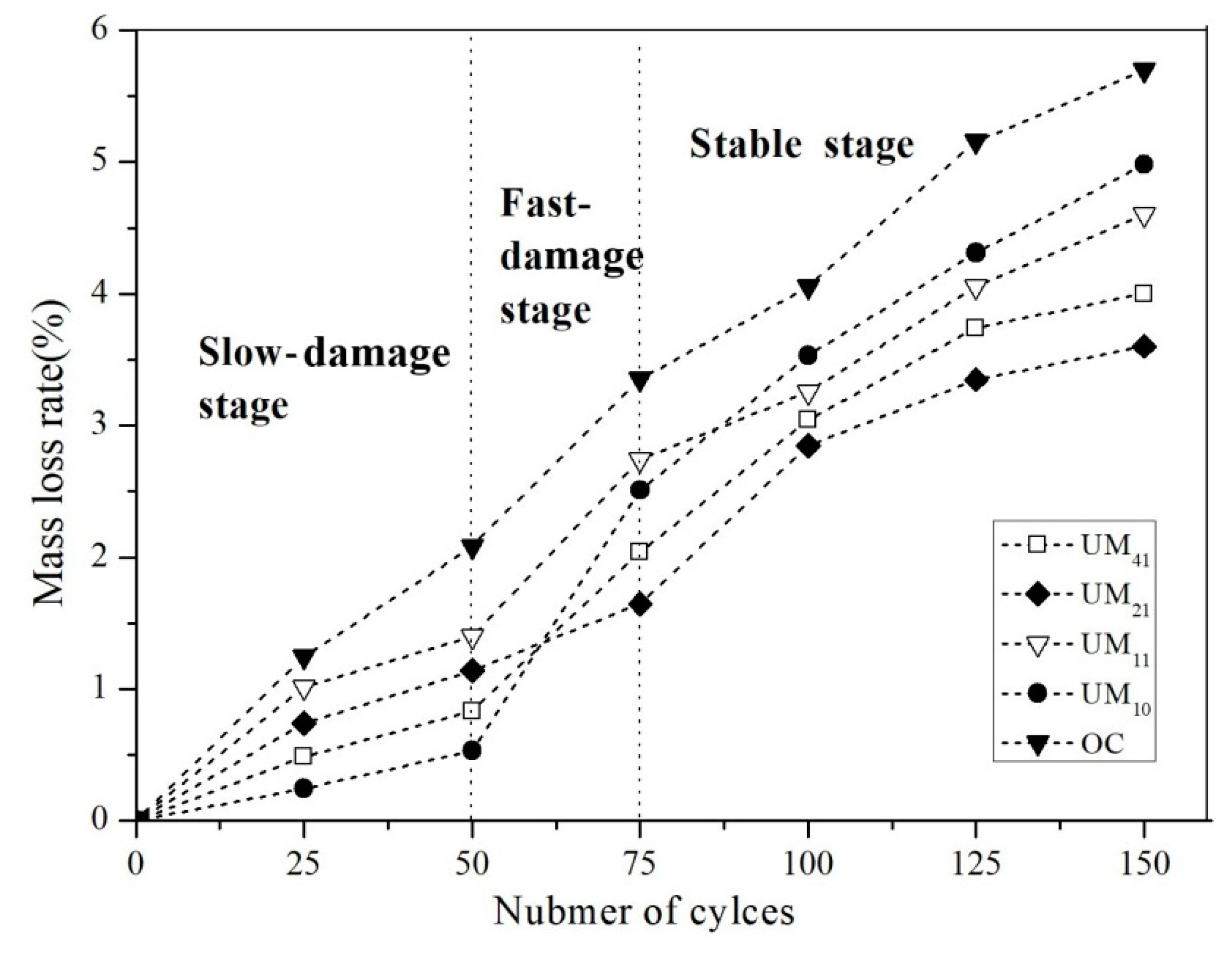
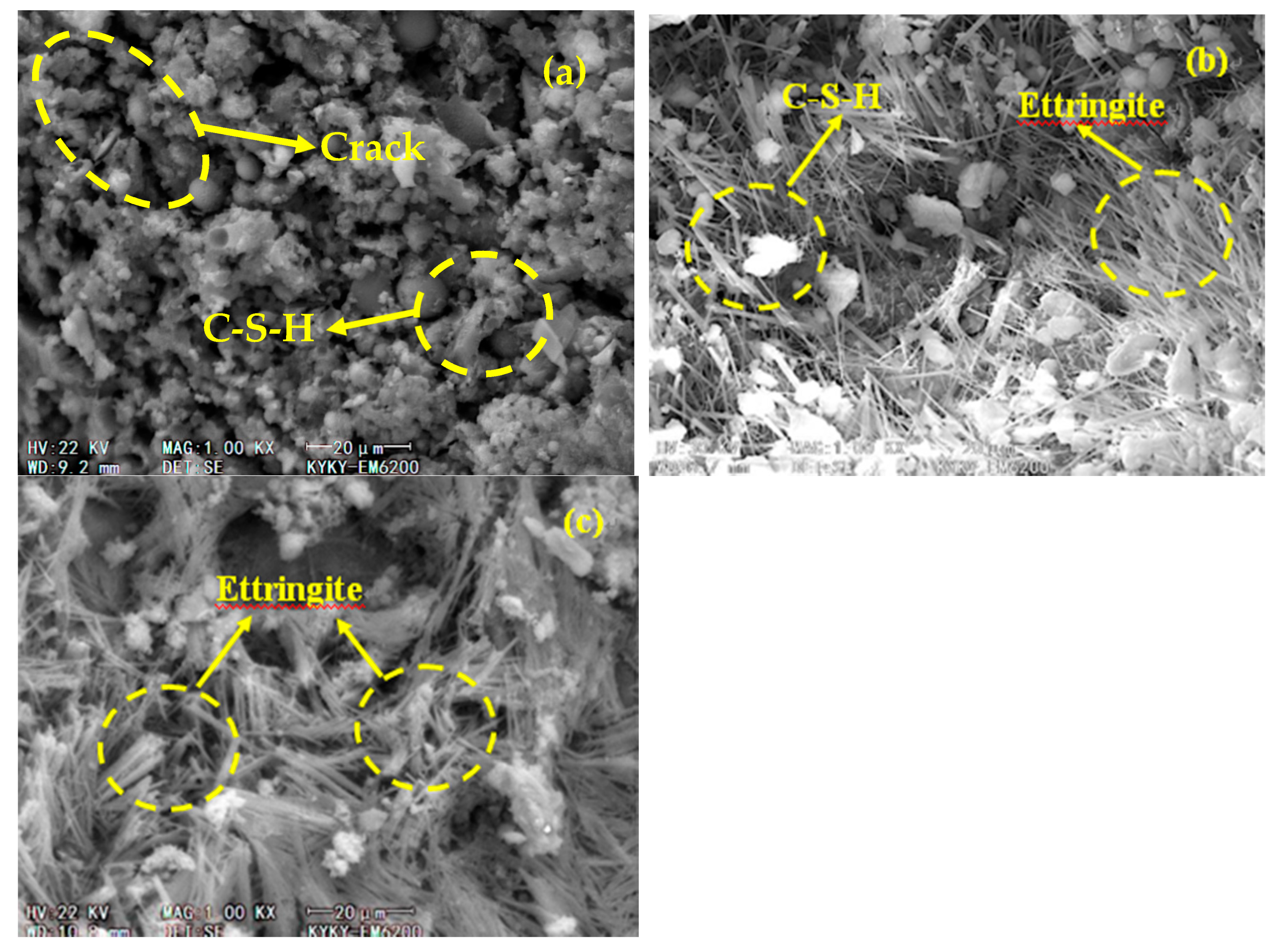


| Items | Fineness (%) | Water Demand Ratio (%) | Loss on Ignition (%) | SO3 (%) | Density (g/cm3) | Water Content (%) | Alkali Content (%) |
|---|---|---|---|---|---|---|---|
| Values | 5.8 | 92 | 3.54 | 1.89 | 2.10 | 0.2 | 1.5 |
| Items | Water Reduction Rate (%) | Bleeding to Water (%) | Setting Time (min) | Compressive Strength | PH | Alkali Content (%) | Chloride Ion Content (%) | ||
|---|---|---|---|---|---|---|---|---|---|
| Initial Setting | Final Setting | 7d | 28d | ||||||
| Values | 19 | 40 | 95 | — | 130 | 123 | 7.03 | 1.23 | 0.046 |
| Items | Fineness | Setting Time (min) | Limited Expansion Rate | |||
|---|---|---|---|---|---|---|
| Specific Surface Area (m2/kg) | 1.18-mm-square Hole Sieve Residual (%) | Initial Setting | Final Setting | 7 d in Water | 21 d in Air | |
| Values | 267 | 0 | 154 | 209 | 0.050 | −0.010 |
| Items | Fineness | Setting Time (min) | Limited Expansion Rate | |||||
|---|---|---|---|---|---|---|---|---|
| 1.18-mm-square Hole Sieve Residual (%) | 80-μm-square Hole Sieve Residual (%) | Initial Setting | Final Setting | 7 d in 20 °C Water | Δξ in 20 °C Water | 7 d in 20 °C Water | Δξ in 20 °C Water | |
| Values | 0 | 1.4 | 235 | 280 | 0.019 | 0.026 | 0.059 | 0.064 |
| Mix No. | Mass of UEA (%) | Mass of MEA (%) | Mix Proportion | Water Binder Ratio | Fly Ash (%) | Sand Ratio (%) | Water Reducing Agent (%) |
|---|---|---|---|---|---|---|---|
| UM10 | 10% | 0 | 1:0 | 0.47 | 20% | 37% | 0.7% |
| UM41 | 8% | 2% | 4:1 | 0.47 | 20% | 37% | 0.7% |
| UM21 | 6.7% | 3.3% | 2:1 | 0.47 | 20% | 37% | 0.7% |
| UM11 | 5% | 5% | 1:1 | 0.47 | 20% | 37% | 0.7% |
| PC | 0 | 0 | -- | 0.47 | 20% | 37% | 0.7% |
© 2020 by the authors. Licensee MDPI, Basel, Switzerland. This article is an open access article distributed under the terms and conditions of the Creative Commons Attribution (CC BY) license (http://creativecommons.org/licenses/by/4.0/).
Share and Cite
Guo, J.; Guo, T.; Zhang, S.; Lu, Y. Experimental Study on Freezing and Thawing Cycles of Shrinkage-Compensating Concrete with Double Expansive Agents. Materials 2020, 13, 1850. https://doi.org/10.3390/ma13081850
Guo J, Guo T, Zhang S, Lu Y. Experimental Study on Freezing and Thawing Cycles of Shrinkage-Compensating Concrete with Double Expansive Agents. Materials. 2020; 13(8):1850. https://doi.org/10.3390/ma13081850
Chicago/Turabian StyleGuo, Jinjun, Ting Guo, Shiwei Zhang, and Yan Lu. 2020. "Experimental Study on Freezing and Thawing Cycles of Shrinkage-Compensating Concrete with Double Expansive Agents" Materials 13, no. 8: 1850. https://doi.org/10.3390/ma13081850




